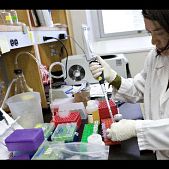
Leads the way in AIDS treatment
Theodora Hatziioannou is an associate professor at the Aaron Diamond AIDS Research Center (ADARC) at Rockefeller University in New York. She is leading a team by scientists, who recently succeeded for the first time ever to infect monkeys with the virus. Their breakthrough will help significantly to the research and treatment of AIDS.
Dr Hatziioannou was born in Rhodes, Greece. She studied at the University of Bristol in Britain and did a postgraduate degree at Imperial College of London. She got her PhD in 1999 from the University Claude Bernard in Lyon-France and did postdoctoral research in Columbia and Rockefeller University (Aaron Diamond Research Center for AIDS).
She works to Aaron Diamond Research Center since then.
The Greek researcher and her colleagues published their study in the leading scientific journal “Science,” and analyzed the development of a new model of macaque (a type of small monkey) who can be infected with an HIV virus that is almost identical to the one that affects humans. The Rockefeller’s Laboratory of Retrovirology also assisted to this study.
Although pigtailed macaques have fewer defenses against HIV-1 than most other primates, they lack an antiviral protein that fights off the virus, the researchers still had to alter both the virus and the macaque immune system in order to induce AIDS.
“This new model for HIV-1 infection is the result of years spent exploring scientific questions about how the virus interacts with a host’s antiviral defenses. These kinds of basic insights will enable us to continue to improve this model” Hatziioannou says.
This marks the first time that scientist have been able to infect a non-primate species (human or chimpanzee) with the AIDS virus. Their goal is eventually to succeed in making a vaccine and anti-viral drug therapies for the fatal disease.
“When we depleted their CD8 cells, the infected monkeys developed disease closely mirroring that of human patients. For example they contracted AIDS-defining conditions including pneumocystis pneumonia, a textbook example of an opportunistic infection in AIDS. Because it replicates what happens when HIV-1 compromises a human patient’s immune system, our approach could potentially be used in the development of therapies and preventative measures for human patients.” Hatziioannou adds.










